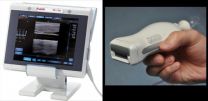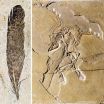(Press-News.org) WASHINGTON, Nov. 5, 2014—A new handheld probe developed by a team of university and industry researchers in the Netherlands and France could give doctors powerful new imaging capabilities right in the palms of their hands. The imaging system, which is described in a paper published in The Optical Society's (OSA) open-access journal Optics Express, shrinks a technology that once filled a whole lab bench down to a computer screen and a small probe about the size of a stapler.
The new device combines two imaging modalities: ultrasound and photoacoustics. Ultrasound is a well-established technology that analyzes how sound pulses echo off internal body parts. It is good at revealing anatomical structures and is, perhaps most familiarly, used to image a developing fetus in a mother's womb.
Photoacoustics is a relatively new imaging technique, still making its way toward widespread clinical applications. In photoacoustic imaging, short pulses of light heat up internal tissue. The slight temperature change leads to a change in pressure, which in turn produces a wave of ultrasound that can be analyzed to reveal information about the body's internal workings. Since this technique ultimately produces ultrasound waves as well, existing technology can be used to analyze and display the images.
The advantage of photoacoustics is that it can reveal important medical information that other imaging techniques cannot, including the presence of molecules like hemoglobin and melanin and the sub-millimeter structure of networks of blood vessels several centimeters beneath the skin. When combined with spectroscopic measurements, photoacoustics can also quantify hemoglobin oxygen saturation within single vessels, providing metabolic information that could be helpful for monitoring tumor progression, for example.
Yet despite these benefits, the cost and size of most photoacoustic systems limit their widespread use, said Khalid Daoudi, a researcher in the Biomedical Photonic Imaging Group at the University of Twente in the Netherlands. Most systems on the market require costly and bulky lasers that make the systems impractical for point-of-care diagnostics. "Our research aimed to break through these hindering factors," Daoudi said.
The project started as collaboration between the University of Twente and three European companies: ESAOTE Europe, a maker of medical diagnostic systems, Quantel, a maker of solid state lasers, and SILIOS Technologies, a maker of optical components.
The team's key innovation, which allowed them to dramatically shrink the system, was the design of an ultra-compact laser based on an efficient and inexpensive laser diode. By stacking multiple diodes to increase the power and carefully designing optical elements to shape the laser beam, the team was able to generate laser pulses with energies higher than had ever been achieved before with diode technology.
Diode lasers can also provide many laser pulses per second, which in turn allows real time imaging, another advantage of the new system, Daoudi noted.
The researchers tested the imaging performance of the system in different types of phantoms—materials designed to mimic a tissue's optical properties—and in a healthy human finger joint.
The new compact probe and imaging system can be easily transported between rooms in a clinical setting, an attractive feature for future commercialization, the researchers said.
The team is currently working with a European consortium of industrial and academic partners to take the next steps from the research to the commercialization phase. The current system operates at a single wavelength in the near infrared, but the team has plans to expand the design to multi-wavelength imaging.
"Some applications targeted are rheumatoid arthritis in finger joints, oncology, cardiovascular disease and burn wounds," Daoudi said.
INFORMATION:
Paper: "Handheld probe integrating laser diode and ultrasound transducer array for ultrasound/photoacoustic dual modality imaging," K. Daoudi et al., Optics Express, Vol. 22, Issue 21, pp. 26365-26374 (2014). http://dx.doi.org/10.1364/OE.22.026365
About Optics Express
Optics Express reports on new developments in all fields of optical science and technology every two weeks. The journal provides rapid publication of original, peer-reviewed papers. It is published by The Optical Society and edited by Andrew M. Weiner of Purdue University. Optics Express is an open-access journal and is available at no cost to readers online at http://www.OpticsInfoBase.org/OE.
About OSA
Founded in 1916, The Optical Society (OSA) is the leading professional organization for scientists, engineers, students and entrepreneurs who fuel discoveries, shape real-life applications and accelerate achievements in the science of light. Through world-renowned publications, meetings and membership initiatives, OSA provides quality research, inspired interactions and dedicated resources for its extensive global network of optics and photonics experts. OSA is a founding partner of the National Photonics Initiative and the 2015 International Year of Light. For more information, visit http://www.osa.org.
If you're inside, chances are you're breathing in low levels of indoor air pollution, a mix of volatile organic compounds and other gaseous substances that can accumulate in buildings and potentially make you sick. An article in Chemical & Engineering News (C&EN), the weekly newsmagazine of the American Chemical Society, describes the latest in air-cleaning technology, including one approach based on a filter for the International Space Station.
Mitch Jacoby, a senior correspondent with C&EN, writes that in recent years, scientists have been gaining a better understanding ...
COLUMBUS, Ohio – A new study reveals the secret of how some fashion and beauty magazines continue to attract devoted audiences, even though they glamorize super-thin models that would seem to taunt normal-sized women.
The research suggests that some readers, rather than comparing themselves unhappily with the thin models, may derive "thinspiration": the belief that they can make themselves look just as attractive as the models they see in these magazines.
But this is not any kind of positive inspiration, said Silvia Knobloch-Westerwick, author of the study and ...
Around 5,000 cases of DCIS, a condition where cancerous cells are contained within the milk ducts of the breast, are diagnosed each year in the UK, with two thirds diagnosed through breast screening. If left untreated, up to half of DCIS cases could progress into invasive breast cancer, but it is not possible to say which ones, so all women are offered treatment.
This usually involves breast-conserving surgery (lumpectomy) and, to reduce the risk of the cancer returning, radiotherapy to kill any remaining cancer cells.
However, even with treatment up to one in five ...
RICHLAND, Wash. – In the Pacific Northwest, young salmon must dodge predatory birds, sea lions and more in their perilous trek toward the ocean. Hydroelectric dams don't make the trip any easier, with their manmade currents sweeping fish past swirling turbines and other obstacles. Despite these challenges, most juvenile salmon survive this journey every year.
Now, a synthetic fish is helping existing hydroelectric dams and new, smaller hydro facilities become more fish-friendly. The latest version of the Sensor Fish – a small tubular device filled with sensors ...
Since 1999, the conjecture by Asher Peres, who invented quantum teleportation, has piqued the interest of many scientists in the field. According to his hypothesis, the weakest form of quantum entanglement can never result in the strongest manifestation of the phenomenon. Today, a team of researchers from the University of Geneva (UNIGE), Switzerland, and the Hungarian Academy of Sciences have proven this conjecture to be false, thus solving one of the most famous problems in quantum information physics. This news was published in Nature Communications review.
The physicist ...
Providence, RI— Results of a new study published in The American Journal of Managed Care show that the presence of a family caregiver during patient recruitment is associated with a greater rate of completion of a post hospital transitional care coaching intervention, particularly among men.
Discharge is a crucial component of the hospitalization process. Patients' understanding and engagement in discharge plans greatly influence their experiences, health outcomes, such as hospital readmission, and overall costs.
The study looked at discharges using the Care Transitions ...
There's more to the decline of the once mighty ancient Assyrian Empire than just civil wars and political unrest. Archaeological, historical, and paleoclimatic evidence suggests that climatic factors and population growth might also have come into play. This is the opinion of Adam Schneider of the University of California-San Diego in the US, and Selim Adali of the Research Center for Anatolian Civilizations in Turkey, published in Springer's journal Climatic Change.
In the 9th century BC, the Assyrian Empire of northern Iraq relentlessly started to expand into most of ...
Washington, DC (November 5, 2014) – Since the 1920s, scholars and politicians have blamed violence in movies and other media as a contributing factor to rising violence in society. Recently the responses to mass shootings in Aurora, CO and at Sandy Hook Elementary followed this theme as media consumption came into the equation. But can consumption of violent media really be a factor in real-world violence? A recent study published in the Journal of Communication by a researcher at Stetson University found that there were no associations between media violence consumption ...
For years, a multidisciplinary team of Johns Hopkins researchers has tracked an elusive creature, a complex of proteins thought to be at fault in some cases of sudden cardiac death. As they report Nov. 5 in the online edition of Nature Communications, they have finally captured images of the complex. Those images reveal the connection between some genetic mutations and electrical abnormalities of the heart and provide a starting point for designing therapies.
Sudden cardiac death is often caused by conditions that affect electrical signaling in the heart. Genetic studies ...
Berlin, Germany (November, 2014) – Reconstructing ancient life has long required a certain degree of imagination. This is especially true when considering the coloration of long-extinct organisms. However, new methods of investigation are being incorporated into paleontology that may shed light (and color) on fossils. Research presented at the recent Society of Vertebrate Paleontology meeting shows the importance of using new imaging technologies in reconstructing the color of Archaeopteryx, one of the most famous and important fossils species.
Ryan Carney of Brown ...




